GRRM20 with Matlantis
"GRRM20 with Matlantis" uses GRRM on Matlantis to realize automated search of chemical reaction paths at revolutionary speeds. Here, we will explain what GRRM can do in general, the benefits of running GRRM on Matlantis, and also introduce some specific examples of using GRRM20 with Matlantis.
About GRRM: Automatically and comprehensively exploring chemical reaction paths
Benefits of combining GRRM and Matlantis: Achieving high-speed, high-precision large-scale searches
About GRRM: Automatically and comprehensively exploring chemical reaction paths
GRRM * is the world's first computational program that automatically searches for unknown chemical reaction paths using the predictive properties of quantum chemistry. New materials, next-generation energy. In all industries, "chemical reactions" are the source of innovation. However, finding the optimal reaction path to express the desired function in a 3N-6-dimensional reaction coordinate space for the number N of atoms involved in the reaction is an extremely complex problem and has been a long-standing challenge. The development of computational chemistry methods for reaction path exploration, including the Nudged Elastic Band (NEB) method and the String method, and computer performance have made it possible to predict by simulation, but these methods require approximate estimates of the initial state (reactants) and final state (products) of the expected chemical reaction, and there was a problem that countless possibilities outside the researcher's knowledge were overlooked.
* GRRM is a registered trademark of the Quantum Chemistry Research Institute. It is provided by HPC Systems. The AFIR method implemented in GRRM is currently being developed by research groups such as those at the Center for Chemical Reaction Design and Development (World Premier International Research Center Program: WPI-ICReDD) at Hokkaido University Creative Research Institute, and is currently being used for cutting-edge research and development aimed at the rational design and rapid development of new chemical reactions.
Characteristics of GRRM
GRRM (Global Reaction Route Mapping) automatically and comprehensively searches for intermediates, transition states, products, by-products, etc., based on quantum chemical calculations, simply by inputting the structure of the initial state (reactants) of a chemical reaction. The core technology that supports this search is the "Artificial Force Induced Reaction (AFIR) method." This method applies a virtual artificial force between molecules or between substructures within a molecule to induce structural changes. By systematically repeating this operation, GRRM comprehensively searches a vast reaction coordinate space beyond the scope of human knowledge and assumptions, and draws a detailed "reaction route map" that reveals reaction routes that convert into unknown products and routes to by-products that cause yield reduction. By analyzing the reaction route map derived by GRRM, it is possible to predict unknown reactions.
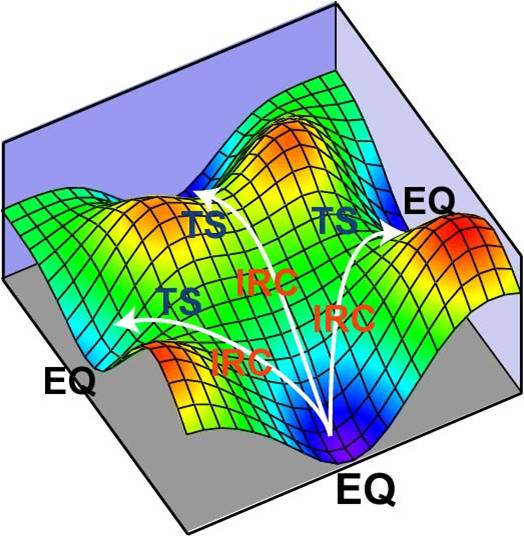
Computational costs are a major challenge
When trying to comprehensively explore reactions with GRRM, one often faces the problem of long calculation times due to the need to perform many highly accurate energy calculations. In particular, applying highly accurate quantum chemical calculation methods (such as DFT calculations) to large-scale systems such as catalytic reactions at surfaces and interfaces is difficult within the time frame required in materials development. To solve this problem, GRRM20 with Matlantis was developed, which uses Matlantis's PFP for energy calculations, etc.
Benefits of combining GRRM and Matlantis: Achieving high-speed, high-precision large-scale searches
"GRRM with its comprehensive search capabilities" and "Matlantis with its ultra-fast calculation capabilities." GRRM20 with Matlantis combines these two capabilities to make it possible to search reaction paths in systems with hundreds to several hundred atoms in a realistic calculation time, which was difficult in the conventional on-premise GRRM environment, opening up new possibilities in reaction path searching.
Dramatically reduce search time
Matlantis' PFP handles the numerous potential energy calculations required in quantum chemical calculations, dramatically shortening the time it takes to search for a reaction path. There have been reported cases where complex reaction path searches that would have taken several months in a conventional computing environment can now be completed in just a few days, dramatically accelerating the trial-and-error cycle in research and development.
Supports large-scale, complex systems with hundreds of atoms or more
Freeing ourselves from the issue of computational costs makes it possible to apply GRRM to large-scale systems where calculations on the time scales required in materials development were previously impractical. For example, we can perform calculations in which reactions previously handled in the gas phase are replaced with reactions on a catalyst surface model, making it possible to elucidate the mechanisms of complex and important phenomena in a more realistic way.
Discover unknown reaction pathways
This comprehensive search can be performed quickly and on a large scale without requiring prior knowledge, allowing searches that were previously limited due to the high computational costs to be performed in a wider range of reaction coordinate spaces. This helps to discover completely new reaction mechanisms and molecular structures with unexpected functions that could never have been reached by human intuition or past knowledge.
Specific use cases
GRRM20 with Matlantis is already demonstrating its power in a variety of areas.
[Catalyst development] Analysis of elementary reactions in carbon monoxide oxidation and hydrogen production catalysts
As a reaction path search in a periodic boundary system, we performed reaction path search for 1) the oxidation reaction of carbon monoxide and 2) the dehydrogenation reaction of methylcyclohexane (MCH) on a platinum catalyst. The usefulness of GRRM20 with Matlantis was demonstrated.
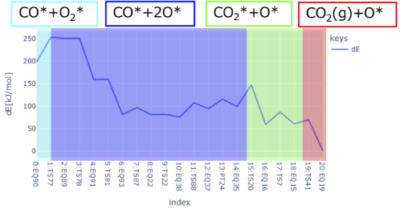
[Semiconductor manufacturing] Analysis of the surface reaction mechanism between ALD precursors and Si substrates
We performed a reaction analysis on silicon surfaces of organometallic compounds used as reactants (precursors) in atomic layer deposition (ALD) and found the most stable pathway. Furthermore, we performed similar calculations for precursors with different allyl ligands, demonstrating the feasibility of quantitatively designing precursors.
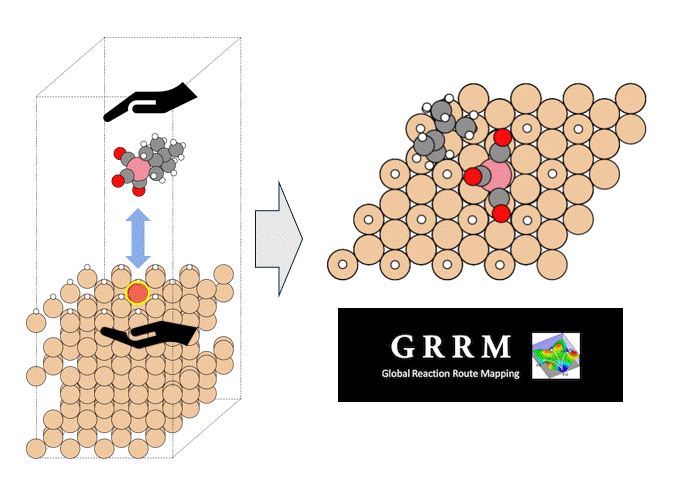
We plan to continue adding application examples in various fields.
Specification
Required Software Packages
The following software packages are required to use GRRM20 with Matlantis.
- Matlantis main unit
- GRRM20 with Matlantis (GRRM20 main unit) *
- GRRM20 with Matlantis Collaboration Package
The linkage package is an interface required to perform calculations such as energy and force calculations that GRRM requests from the quantum chemistry calculation package using Matlantis PFP.
*The GRRM20 with Matlantis main unit will be provided by HPC Systems.
price
We are currently accepting trial orders (1 or 3 months). Whether you have not yet introduced Matlantis or you have already signed up for Matlantis, you can try out the effectiveness of GRRM20 with Matlantis. Please contact us for details on pricing and trials.
Contact us for more information about pricing plans and trials.
Support System
As with Matlantis, please contact our technical support.
(We will work with HPC Systems as necessary.)
Calculations that can be performed with GRRM20 with Matlantis
Automatic reaction path search by the ADDF method (ADDF)
The reaction path is searched by climbing the potential surface from the stable structure. For automatic reaction path search using the ADDF method, please refer to the following literature.
- K. Ohno, S. Maeda, Chem. Phys. Lett. 2004, 384, 277.
- S. Maeda, K. Ohno, J. Phys. Chem. A 2005, 109, 5742.
- K. Ohno, S. Maeda, J. Phys. Chem. A 2006, 110, 8933.
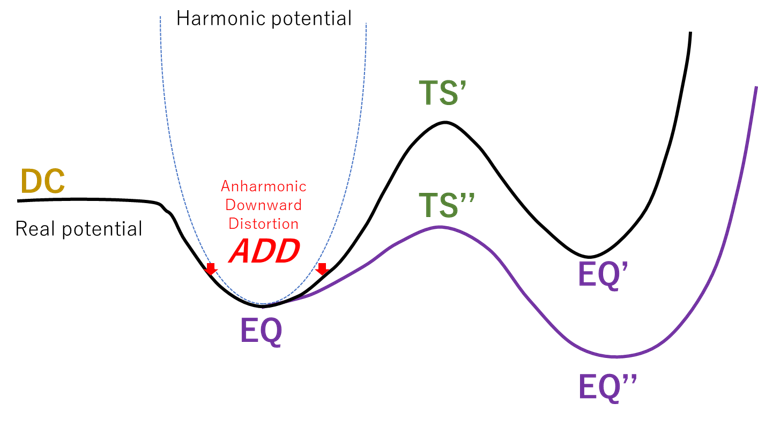
Automatic reaction path search using AFIR method (MC-AFIR, SC-AFIR, DS-AFIR)
The AFIR method searches for reaction paths by applying artificial forces between atoms to induce reactions. For more information on automatic reaction path searches using the AFIR method, please refer to AFIR-web and the following literature.
- Chem. Rec., 2016, 16, 2232.
- WIREs Comput. Mol. Sci., 2021, 11, e1538.
- For other features of GRRM17, including the AFIR method, please refer to the following literature.
- J. Comput. Chem., 2018, 39, 233.
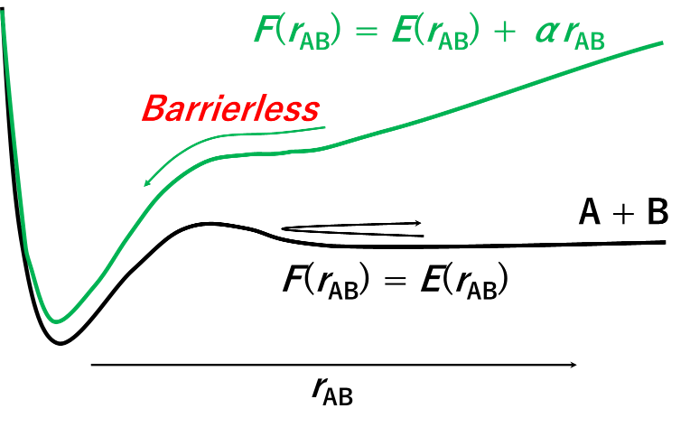
AFIR route improvement (LUP, RePath)
Optimize the reaction path obtained by the AFIR method.
Normal Mode Analysis (FREQ)
Obtain the frequency and normal coordinates of the normal vibration.
Stable structure optimization (MIN)
Optimize stable structures with high precision.
Transition structure optimization (SADDLE)
Optimize transition structures with high accuracy.
Intrinsic reaction coordinate tracing (IRC)
Track IRC with high accuracy.
Reaction intermediate analysis (SCW)
It searches for intermediates (stable structures) between two coordinates with high accuracy.
Two-point transition state search (2PSHS)
It searches for transition structures between two coordinates with high accuracy.
Automatic reenergy calculation (ReEnergy)
Change the calculation level and perform single point calculations for existing structures (EQs, PTs, TSs) all at once.
Automatic restructuring optimization (ReStruct)
Change the calculation level and perform structural optimization of existing structures (EQs, PTs, TSs) all at once.
About Citation
- For citations of GRRM20, please refer to the Citation of the program and related papers page on AFIR-web. (To access this page, you must register with AFIR-Web. HPC Systems will inform you of the registration procedure when you purchase the GRRM20 with Matlantis main unit.)
- See Matlantis' citation here.

